“The Man Trap”
Written by George Clayton Johnson
Directed by Marc Daniels
Season 1, Episode 5
Production episode 6149-06
Original air date: September 8, 1966
Stardate: 1513.1
Captain’s log: Kirk, McCoy, and Darnell beam down to M-113 for a routine medical check on two archeologists stationed there, Professor Robert Crater and his wife Nancy Crater. The latter is an old flame of McCoy’s. When they meet, he says she hasn’t aged a day—and to him, she hasn’t. But Kirk sees her as an older woman, while Darnell sees her as a hot blonde he canoodled with on Wrigley’s Pleasure Planet.
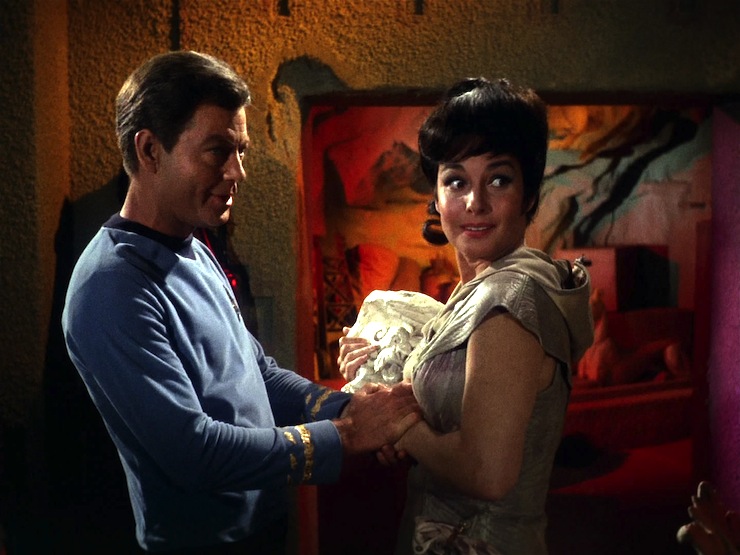
When Nancy goes to fetch Crater, she goes outside, and appears to Darnell as the hot blonde again, leading him away from the base with her butt-wiggle. However, Crater shows up on his own, and is snotty and obnoxious and unwilling to accede to the required physical. But McCoy insists, and Crater actually becomes more conciliatory once he realizes that the doctor is Nancy’s old flame.
In mid-exam, they hear a scream. Kirk whips out his phaser and runs to see Nancy standing over Darnell’s dead body. She says that he ate a Borgia plant, which is poisonous, and she wasn’t able to stop him in time. McCoy, meanwhile, is bumfuzzled because Nancy now looks to him the same way she does to Kirk, with gray hair.
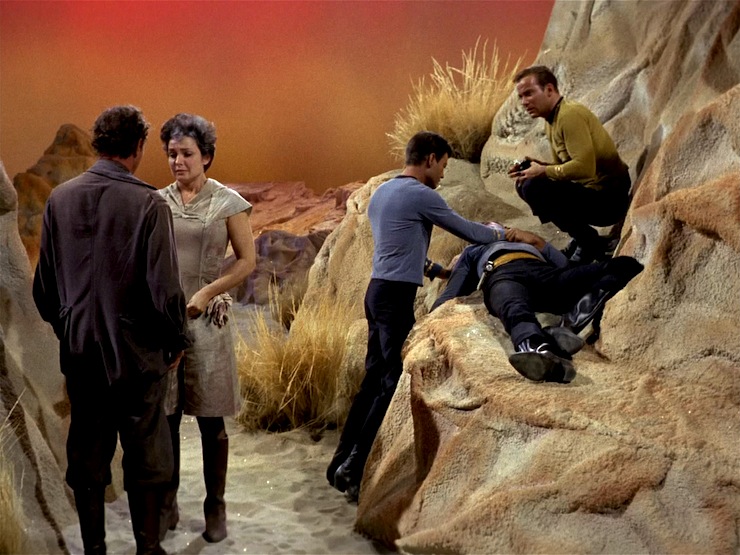
McCoy brings Darnell’s body to the ship. The Borgia plant is an alkaloid poison, but McCoy can find no trace of such a poison in his system, and the red mottling on Darnell’s skin isn’t a side effect of the Borgia plant. However, McCoy does discover that Darnell has no salt in his body whatsoever—and both Craters mentioned that they were low on salt tablets, though Crater says it’s to deal with the heat. Nonetheless, it’s suspicious, so Kirk leads a landing party. Crater insists that they’re just low on salt, and shows Kirk a nearly empty bottle of salt tablets to prove it.
Crater runs off before Kirk can beam him back up to the Enterprise, where he wants the Craters to stay until they find out what killed Darnell. They come across the dead body of Sturgeon, and elsewhere Nancy is standing over Green’s dead body. Nancy then changes to look like Green and reports that he found Sturgeon’s body. Nancy is still missing, so Kirk orders the landing party to beam back and has Spock search the surface using the Enterprise’s scanning equipment.
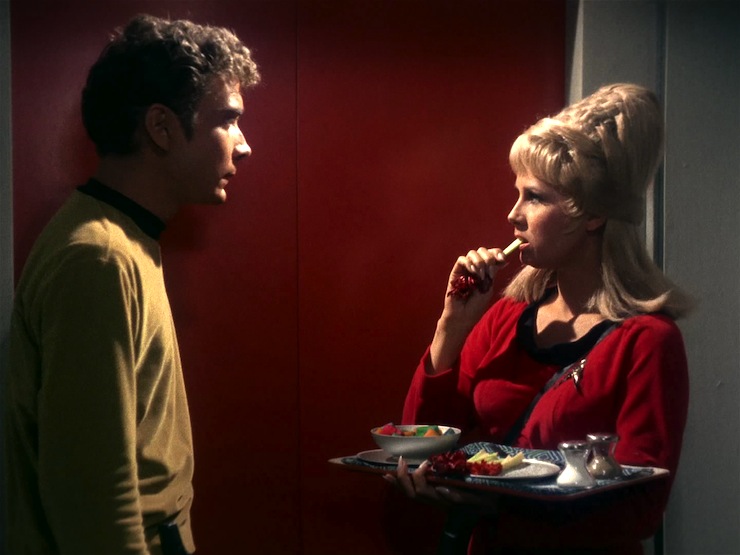
The creature disguised as Green comes across Rand holding a tray of food, and tries to grab the salt shaker before Rand smacks his hand. Green follows her to the arboretum, where she gives the tray to Sulu. (Along the way, several crewmembers leer at her creepily.) One of the plants reacts badly to Green’s presence and he leaves quickly, leaving a very confused Sulu and Rand behind.
When Uhura steps into the corridor from the turbolift, Green changes into a tall handsome dark-skinned crewmember, who speaks Swahili to her. However, Kirk summons her to the bridge before he can attack her, so instead it goes after another crewmember, Barnhart, then finds McCoy’s quarters, and then changes back into Nancy. McCoy is gobsmacked, and surprised Kirk didn’t tell him that they found her. She encourages him to take a sleeping pill and get some rest, and once he does, she changes to look like McCoy—and then answers the call for a medical team made when Sulu and Rand come across Barnhart’s body.
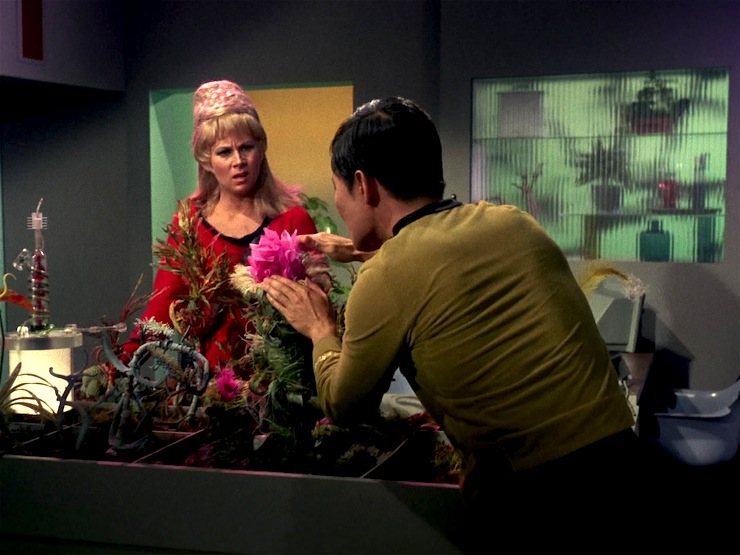
Spock can only find Crater on the planet, so he and Kirk beam down to find out what’s going on. They find Crater hiding behind a rock with a laser pistol, and Spock also finds Green’s dead body. Kirk orders Sulu to go to General Quarters and says there’s an intruder alert, who may look like Green. The creature now posing as McCoy goes to the bridge, and learns that Sulu, Rand, and Uhura have figured out that the creature can change shape—although it’s McCoy himself who uses the word “creature” for the first time, which surprises Sulu.
Crater uses the pistol on Kirk and Spock, damaging the very ruins he’s supposed to be studying, but they flank him and stun him. Crater finally admits that Nancy is dead, killed by the creature who is the last of its kind. It can assume any shape. Crater insists that it’s only doing what it has to in order to survive, and the creature uses McCoy’s face and voice to try to justify keeping it alive. Crater refuses to assist Kirk in finding the creature, and Spock suggests truth serum. Spock, Crater, and McCoy proceed to sickbay, but then the creature jumps them. It kills Crater and tries to kill Spock, but his blood doesn’t have sufficient salt content to be of use.
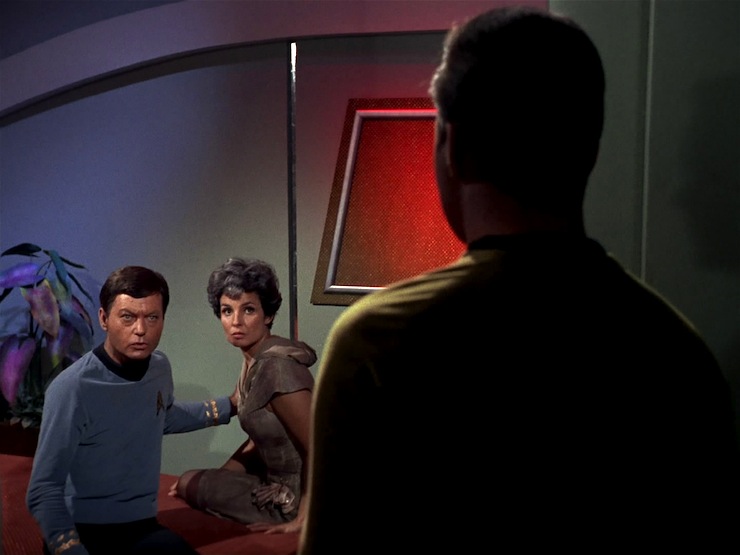
The creature returns to McCoy’s quarters, reassumes Nancy’s form, and says that they’re trying to kill her. Kirk shows up with a phaser in one hand and salt tablets in the other. McCoy stands between Kirk and Nancy, and then Nancy attacks Kirk, hungrily going for the salt tablets. Spock enters and tries to get McCoy (who now has Kirk’s phaser) to shoot her, but he won’t attack his wubby. Spock slugs Nancy several times, and she barely flinches, then she backhands Spock across the room.
McCoy finally starts to maybe think that perhaps this isn’t Nancy, but doesn’t actually shoot until the creature assumes its true (icky) form and tries to kill Kirk.
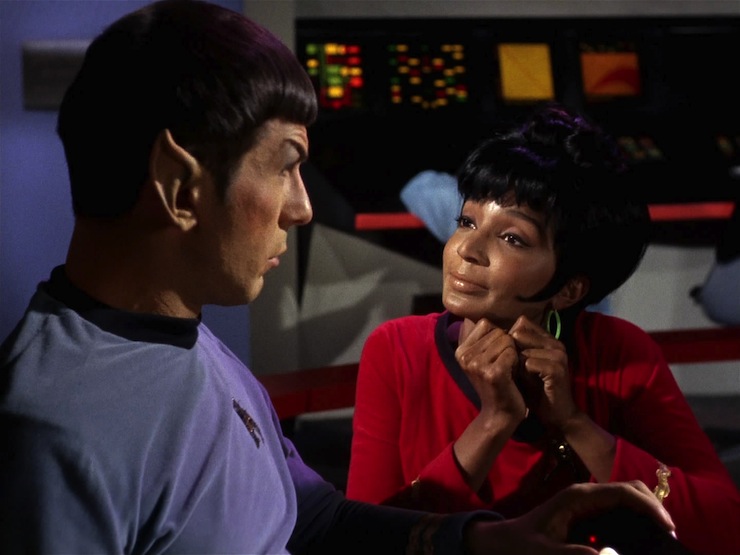
Fascinating: Spock’s native planet is identified for the first time as Vulcan—matching Mudd’s “Vulcanian” line—and his conversation with Uhura shows his value of logic over emotion quite succinctly with his confusion by small talk and unwillingness to show emotion at the news that a member of the landing party is dead.
I’m a doctor not an escalator: We get a glance into McCoy’s past, as we meet the woman who got away, whom he obviously still has feelings for. Nancy’s presence clouds McCoy’s judgment, though it’s to his credit that even when he sees through the creature’s disguise, he isn’t willing to fire on it until Kirk’s life is in danger, and even then, he does so reluctantly.
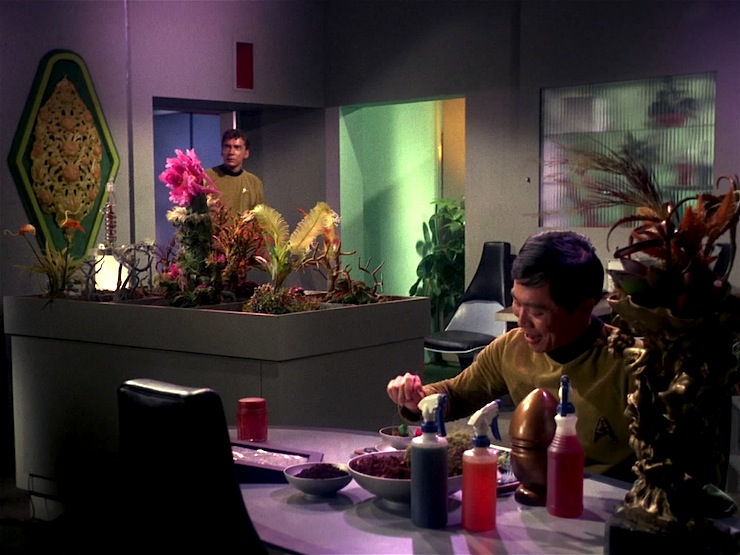
Ahead warp one, aye: Sulu is in charge of the bridge in the absence of Kirk and Spock, and he supervises the shift to General Quarters and the search for the creature on board. We also see his botany hobby, as he’s futzing around in the arboretum while off duty, including arguing with Rand over what to name the semi-sentient plant (Beauregard or Gertrude).
Hailing frequencies open: The opening shot (which is actually a reuse of a shot that will be seen in “The Naked Time”) shows Uhura at the navigation console. Also, the early scene with her chatting up Spock is Exhibit A in the argument that Roberto Orci and Alex Kurtzman did not pull the Spock-Uhura romance out of their asses in the 2009 Star Trek and Star Trek Into Darkness.
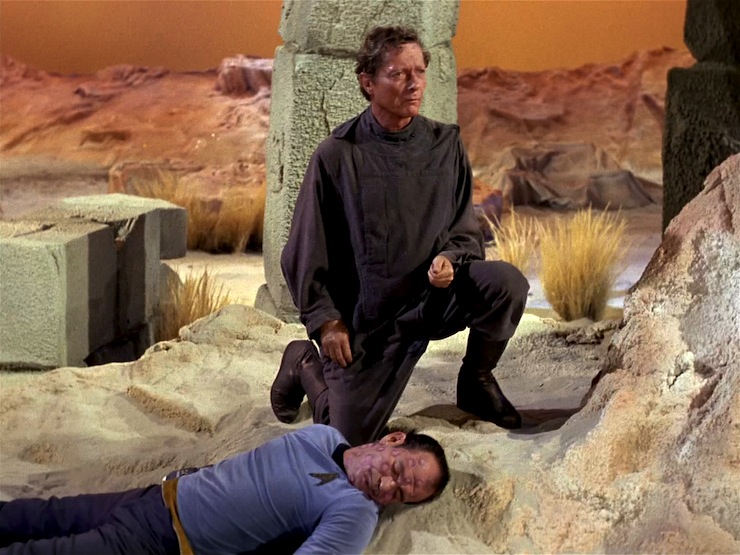
Go put on a red shirt: High body count in this one (though, amusingly, none of them wear red; the only security guards we see are on the ship enforcing General Quarters, but they all survive), losing Darnell, Green, Sturgeon, and Barnhart (as well as Crater), and only one of those crewmembers actually gets dialogue (all of “Green’s” dialogue is actually the creature’s).
No sex, please, we’re Starfleet: Where to even start! We’ve got Darnell and his memories of Wrigley’s Pleasure Planet (and the creature using those memories to lure him to his doom), we’ve got two crewmembers leering over Rand like big-city construction workers, we’ve got Uhura flirting with Spock and seeing a good-looking black man, we’ve got McCoy mooning over Nancy interfering with his judgment…
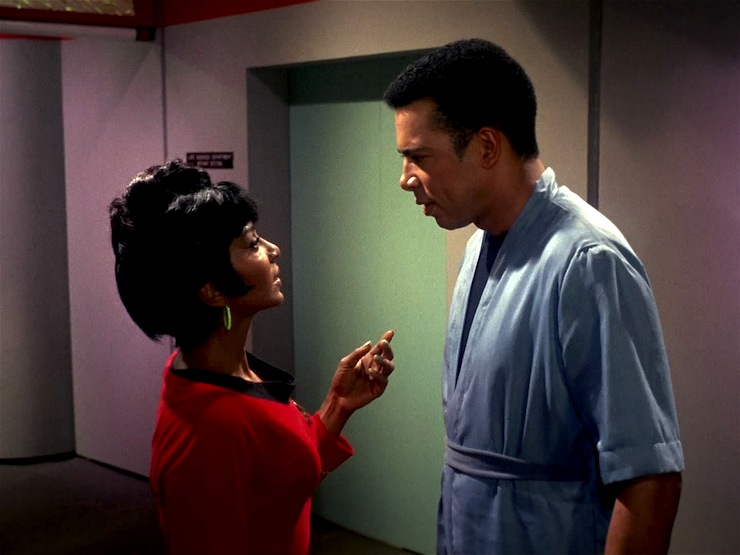
Channel open: “Starship Base on Corinth IV requests explanation of our delay here, sir. Base Commander Dominguez says we have supplies he urgently needs.”
“Tell José he’ll get his chili peppers when we get there. Tell him they’re prime Mexican Reds, I handpicked them myself. But he won’t die if he goes a few more days without them.”
Uhura and Kirk in a bit of business that has nothing to do with the episode, but which adds delightful texture to it.
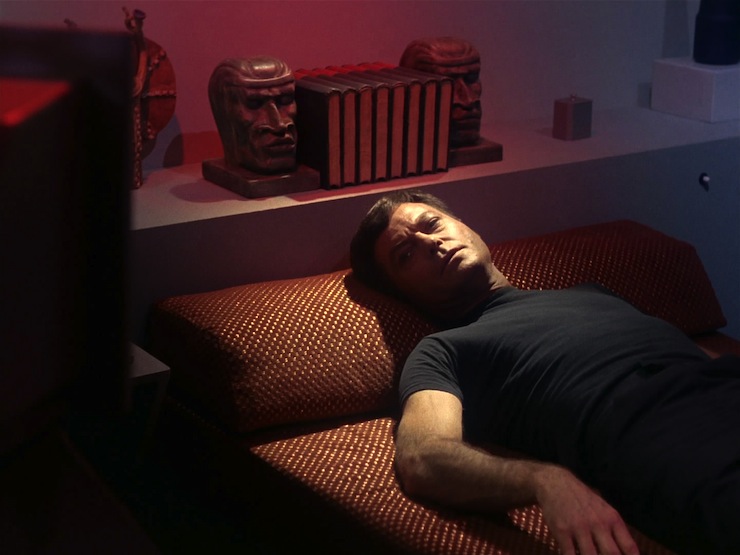
Welcome aboard: Alfred Ryder plays Crater, while Bruce Watson and Michael Zaslow play Green and Darnell, respectively. Plus we have recurring regulars DeForest Kelley, George Takei, Grace Lee Whitney, and Nichelle Nichols.
The creature is played by Jeanne Bal (image of Nancy), Francine Pyne (image of the woman from Wrigley’s Pleasure Planet), Vince Howard (image of the crewmember Uhura sees), and Sharon Gimpel (the creature’s true form), as well as Watson and Kelley.
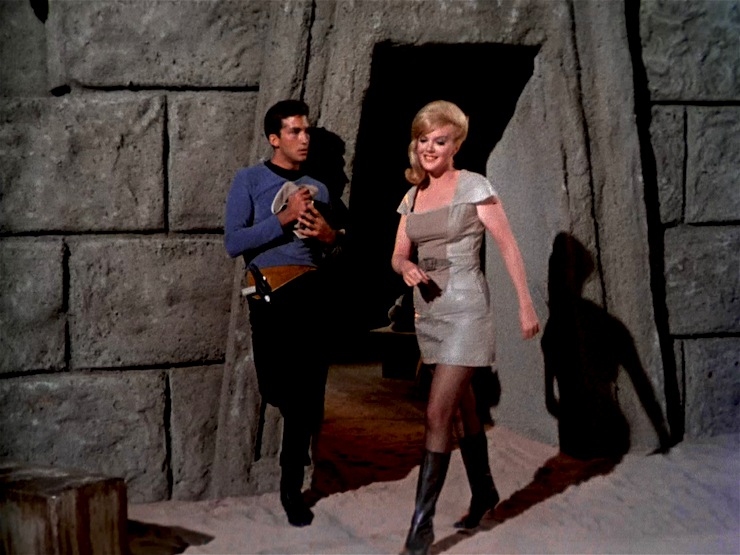
Trivial matters: As probably everyone reading this knows, “The Man Trap” was the first episode of Star Trek to actually be aired on NBC, cementing the 8th of September as a nerd holiday for decades to come.
This is the only Trek script by George Clayton Johnson, best known for co-writing the novel Logan’s Run and for penning many Twilight Zone episodes. It’s also the first Trek directing effort by Marc Daniels who would be one of the two most prolific directors on the original series, along with Joseph Pevney.
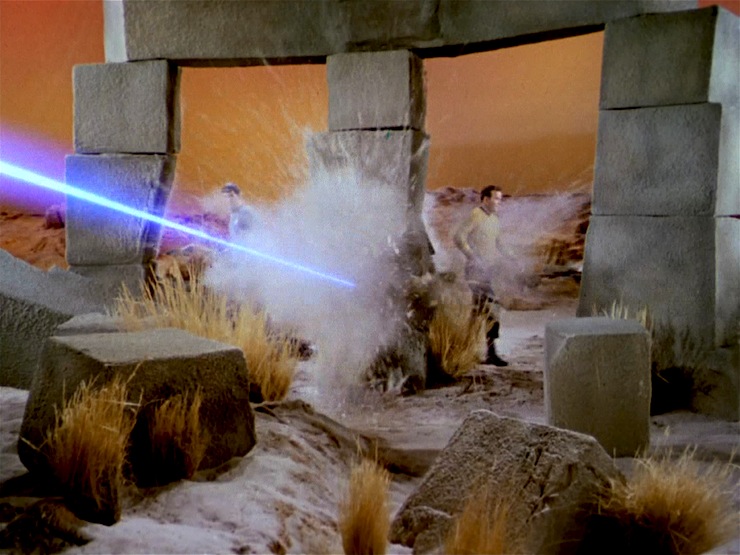
Early drafts of the script were titled “Damsel with a Dulcimer” and “The Unreal McCoy,” the latter being the title James Blish used in his adaptation in Star Trek 1; Blish used the name Bierce instead of Crater and Regulus VIII instead of M-113, probably from the earlier-draft script he was working from. Bierce/Crater also survived to the end of the story, a change Gene Roddenberry made during his final polish of the script.
Uhura switches from a gold to a red uniform, which she’ll maintain for the rest of the series.
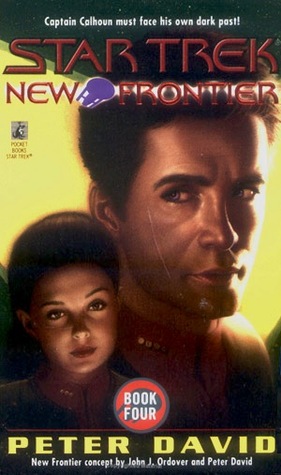
Sulu references “the Great Bird of the Galaxy,” which was actually the nickname that Robert H. Justman coined to refer to Roddenberry. The Great Bird is later actually seen in the early New Frontier novel End Game by Peter David as an energy creature that hatched inside a planet after gestating for millennia.
This is the only onscreen reference to Wrigley’s Pleasure Planet, though it shows up in various works of tie-in fiction, including the comic book Star Trek Annual #1 written by Mike W. Barr, the FASA role-playing game, the eBooks The Future Begins by Steve Mollmann & Michael Schuster and Lust’s Latinum Lost (And Found) by Paula M. Block & Terry J. Erdmann, and your humble rewatcher’s novels The Art of the Impossible and A Singular Destiny.
Spock tells Uhura that Vulcan has no moon, though the animated episode “Yesteryear” and The Motion Picture both gave Vulcan satellites. The latter was corrected in the director’s cut, and a fan writer named Gordon Carelton proposed in 1975 that the other planet in “Yesteryear” was a sister planet, not a moon, which was dubbed T’Khut, which several tie-in writers have used.
To boldly go: “Go away, we don’t want you!” This is not an episode I’ve rewatched often—not due to the episode itself, but due to the fact that it was one of the first Trek episodes I remember watching as a little kid, and the true form of the creature gave me nightmares. Seriously, that thing haunted me for years. I couldn’t watch this episode at all again until college…
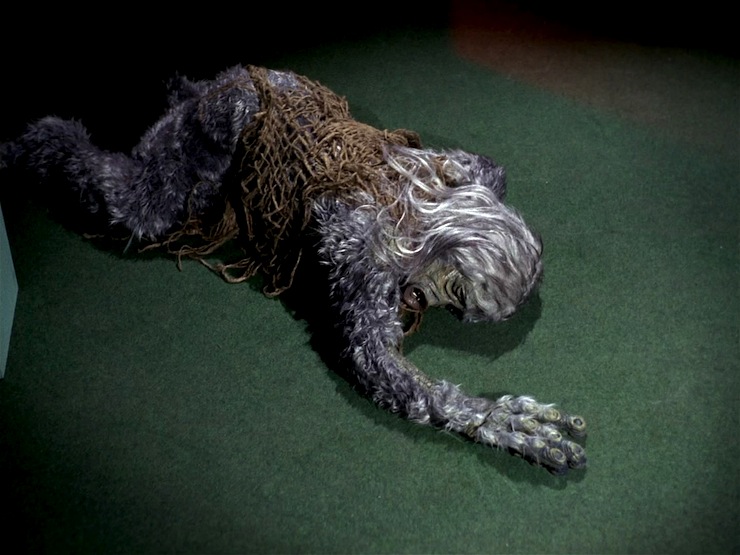
When I finally did, I realized that it was a good, solid Star Trek episode (with a very scary-looking creature finally seen at its climax). Avoiding the clichés, the creature isn’t just a monster that has to be killed—Crater and the creature itself make a good argument for why they shouldn’t commit genocide by killing the thing. The buffalo analogy is not too sledgehammery, and I like that killing it was a last resort. It’s a good vehicle for DeForest Kelley, making another in a lengthy series of cases to make him an opening-credits regular, showing McCoy’s fallibility (he’s verklempt for most of the episode mooning over Nancy) but also his underlying compassion—in the end, he won’t commit violence until he has to, as he realizes that it isn’t really Nancy as soon as the creature backhands Spock across the room, but it’s not until several seconds later, when Kirk’s about to be killed, that he shoots the phaser.
In addition, the easy rapport among the crew remains delightful. Some of it has aged really badly—Uhura’s attempt at small talk with Spock is wince-inducing and the crewmembers leering over Rand is vomit-inducing—but others are fantastic, from Sulu and Rand’s gabbing in the arboretum to Kirk’s eye-rolling at Commander Dominguez’s attempt to get his chili peppers sooner. And I must admit to loving that the creature is inclusive: appearing as a hot blonde chick to Darnell and as a sexy black dude to Uhura.
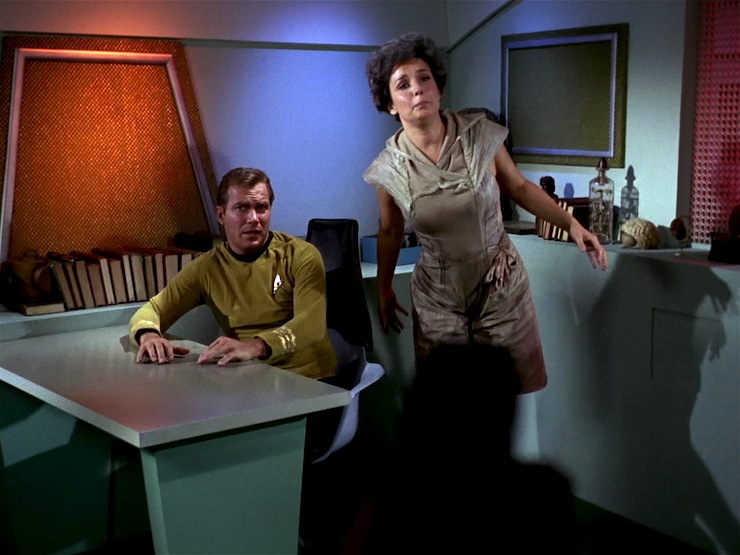
But the episode suffers from way too much padding and one antagonist who just doesn’t work. Crater is all over the map, being obdurate to start, then suddenly becoming polite when he realizes his wife’s ex is there (?), then willing to hole up with a pistol rather than go to the Enterprise, then being all nice and science-y in the briefing room (though not enough to help the crew), and none of it makes any sense except insofar as it keeps the episode moving when the plot itself isn’t doing enough of a job of that. To make matters worse, we’re never given a good reason why he’s being so conciliatory to the creature who murdered his wife, nor why he’s so uncaring about the murders of Darnell, Green, Sturgeon, and Barnhart. Alfred Ryder’s stilted and overenunciated line readings don’t help matters, as he’s less a character than he is a guy reading lines.
Warp factor rating: 5
Next week: “The Naked Time”
Keith R.A. DeCandido has a bunch of cool things coming out in 2015, including a story in The X-Files: The Truth is Out There, a new Cassie Zukav story in Buzzy Mag, a story in V-Wars: Night Terrors, the novel Mermaid Precinct, the Stargate SG-1 novel Kali’s Wrath, and the short story collection Without a License.










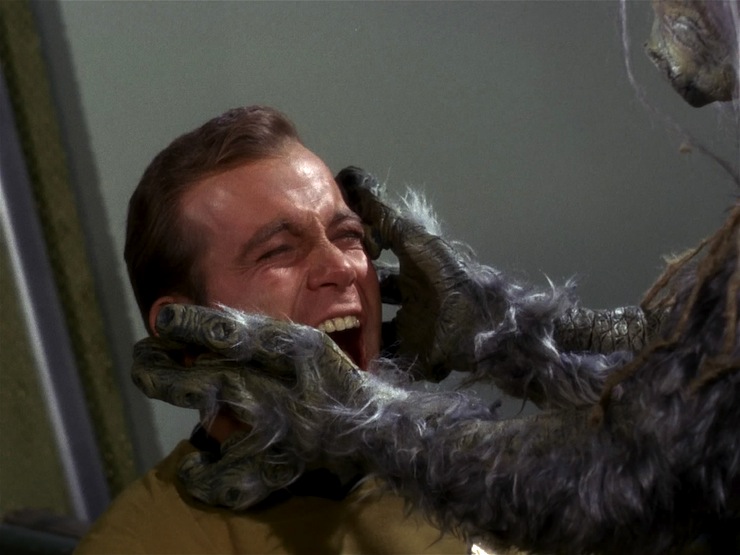
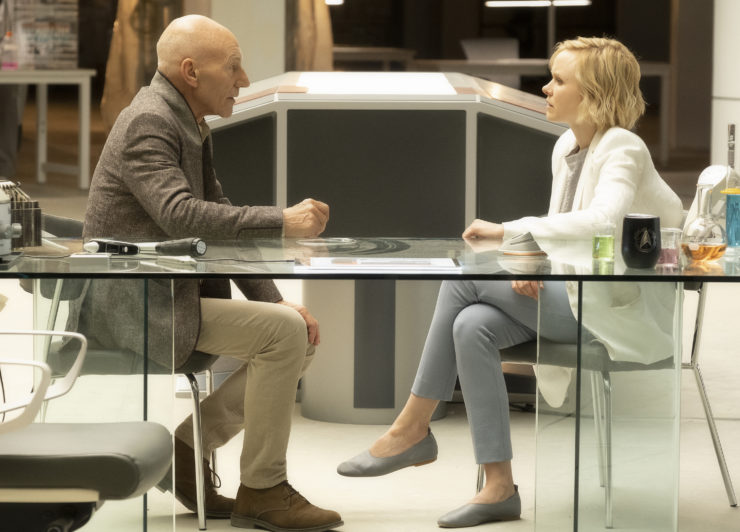
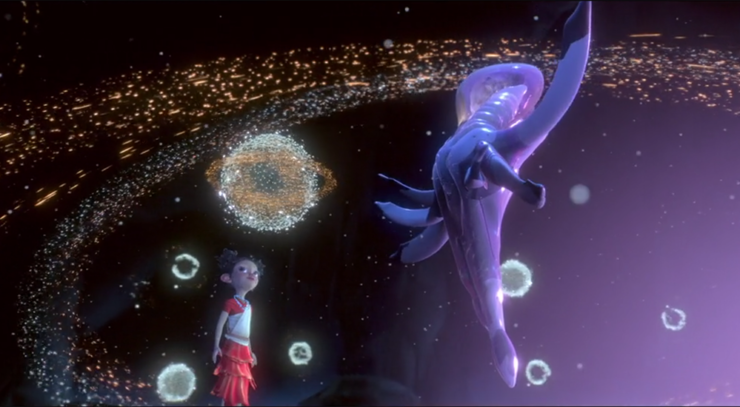
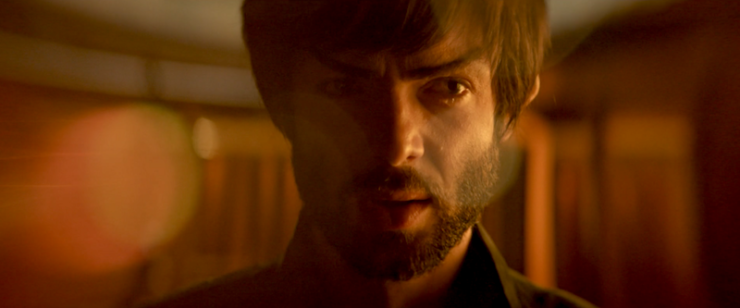
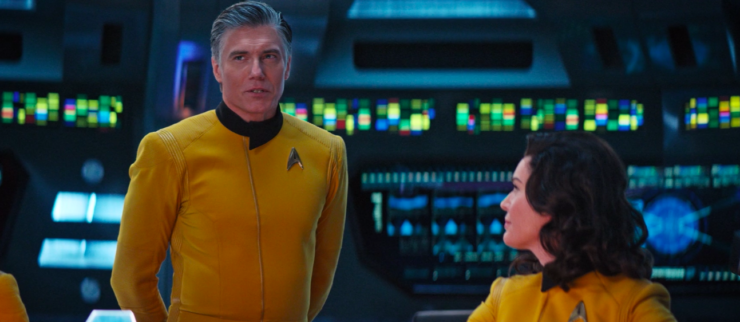
It is a good episode (and you deliver a great write-up of it). I’ve always thought Nimoy was unfair to it when he said, in his 1982 Star Trek Memories special, “The critics didn’t like us, and rightly so.” It does have the huge plot hole (at least as I see it) of why don’t they just give the thing some salt? (Maybe I missed something.) Ultimately, it is just a monster to be killed because Kirk, Spock, and the crew decide to treat it that way. Only once it’s killed does Kirk turn wistful remembering the buffalo. It’s a very un-Star Trek way to go, as the series would later develop–yes, the creature kills crew members, but plenty of other misunderstood “monsters” do in later stories and don’t have to die for it. Maybe some tie-in fiction since has massaged it to make it work. In any event, as a standalone adventure, it’s got such good pacing and performances, I usually give it a pass. Trek could have had a better first aired episode, but it also could have had a lot worse (“Mudd’s Women,” cough, cough.)
Meaningless observation I had this time through: The unseen Commander Dominguez shares a first name with Commodore Mendez of Starbase 11 (“The Menagerie”). I like that little bit, too, mainly becasue it was cut from syndication (for time, I imagine) and I never saw it until a few years ago.
The death of the creature is still not in keeping with later Star Trek, even if McCoy waited until it attacked Kirk. I don’t think anyone ever directly asked the creature, “what do you want” or even “do you have a name?” It was obviously sentient and could speak when in human form, so it wasn’t just a mindless feeding machine and it makes no sense it would try to attack Kirk in a room with two other armed humans watching. Instead using the salt as bait, just hand it over to keep it alive and then talk to it.
“What do you want? Do you want to be left alone? Since you’re the last, do you want to come to space with us and help us research your culture? (Although you may be tried for murder.) We can provide salt and anything else you require so you won’t have to kill again. We have lots of weird races in the Federation, you’ll fit right in.”
Contrary to Mudd’s Women which never worked and never should have gone into production, there’s potential for a good episode here. But it’s hidden by a veil of a generic monster hunt.
According to Johnson and what you can read in Cushman’s book the script fleshed out Crater and the creature more and that’s indeed where the gold in this story is to be found.
Crater is indeed not clearly enough characterized but so is also the salt vampire. Is it a wild beast who instinctively hunts and kills? But since it seems able to mimic social behaviour, it seems to be able to repress those urges. I don’t quite get why it ever behaves like a monster. Wouldn’t it be productive to just ask for salt?
Yes, a nice episode, although they should not have killed the creature. On the other hand, that’s the first time we see how protective Kirk is where his crew is concerned.
I love the scene between Uhura and her “crewman”. Are they really speaking Swahili?
I also like that the marks on the dead crewmen’s faces remain mysterious up to the point when we see the creature in its true form – then it’s all immediately clear.
Oh, and I like the red sky on the planet.
By the way, did you see the female crewmember with the pants after the intruder alert? See – miniskirts are voluntary after all.
“And I must admit to loving that the creature is inclusive: appearing as a hot blonde chick to Darnell and as a sexy black dude to Uhura.” I don’t see that as inclusive since the creature seems to assume humans are attracted only to people of their own race. Racist salt monster is racist!
I also wondered why they didn’t just give the creature some salt! I can see how it might be a problem if it could take it only by sucking it out of another being like a giant salt mosquito, but that wasn’t the case. Give it all the salt it needs until they can figure out what to do with it.
I also wondered why Nancy and Bones split up especially since they seemed to hold not ill feelings against each other. Filling in that backstory would be interesting.
@5 –
Or “racist” salt monster, being you know an ALIEN, doesn’t have centuries of race related baggage to sort through and assumes that creatures that look similar will be more likely to be attracted to each other, which has the additional benefit of being true more often than not.
I’m a huge fan of this episode, despite some flaws. DeForest Kelley and William Shatner have great chemisty together and is shows. The first scene in the “Dispensary” crackles with energy; I love Kelley’s delivery of “Jim, don’t tell me my business”. And Kirk’s line about mysteries giving him a bellyache is terrific.
I was always impressed how good the effects were when Crater used the laser on the ruins. It looked great and shows that a real explosion looks better than CGI any day of the week.
I really like this episode, mainly for the interaction among the crew. Kirk and McCoy’s easy-going banter at the top of the episode, Sulu and Rand getting on as though they’ve known each other for years, and, although awkward, I really like the scene with Uhura poking at Spock, mostly from boredom. Uhura gets to be a person in this episode; she’s featured here in a way not really seen again in the rest of the series. Uhura faces the danger of the creature and only narrowly escapes (I agree its awesome the creature turned into a handsome black man for her), and she even gets to talk in the briefing room, saying more than “Call from the bridge, Captain” here. I wish we had seen more of this.
The whole mood and feel of the episode is just great here. The whole monster hunt theme can be forgiven because the creature is actually given a voice (several voices technically). Just a great hour.
My perspective is limited by being a white male, but I don’t see anything racist about the fact that the creature transformed into a black man for Uhura. Uhura later says she was thinking about a man just like the one she saw. The creature read her thoughts (to whatever extent it can), and obliged. People can be attracted to all sorts of people, including those from their own ethnic backgrounds.
Unless, Pikkewyn, your comment was intended as a funny, in which case I am being a pedantic bore (which has been known to happen) :)
Agree with all who say the easy camaraderie among the crew is one of the best things about this episode. Why did this wither away so quickly after the early first season? Time constraints of getting scripts done? Focus shifting more and more to Nimoy and Shatner? At least we got as many nice character moments among the others as we did during the rest of the series – otherwise, these folks would not have stuck in our memories as much as they have.
@5/Pikkewyn: As I understand it, the creature is a mind reader and displays the form its prey wants to see. Nothing racist about that.
Uhura’s crewman: “You were just thinking of someone like me.”
@9/Mike: You beat me by one minute! And yes, it’s a pity they lost this kind of interaction among the crew in later episodes. I was really pleasantly surprised when I watched it for the first time, because I had only known it was about a monster hunt.
@5, the salt creature isn’t racist. The creature read Uhura’s mind and took the form it read from her thoughts. I am quite sure the creature gave no thought whatsoever to skin color, only to being able to distract Uhura long enough to draw salt from her. Being black myself, I have to be sensitive to these things, but in this case, there’s no there there.
In Portuguese, this episode was titled “The Salt of the Earth“. That was a better title. So was The Unreal McCoy, for that matter. I never liked the title The Man Trap. Too on the nose. And rather sexist, for that matter (much like the Starfleet officers leering at Rand – WHERE WAS THEIR EVOLVED SENSIBILITY???).
There are good things about this episode, namely the work done on secondary characters, showing the inner workings of the ship. Uhura and Sulu felt like real people. And it gave a good insight into the Spock-Kirk-Bones relationship, as well. Character-wise, this is a pretty solid entry. Plot-wise, it’s a messy monster of the week. Full of holes, with the worst case of pacing I’ve seen. A case where more commercials would actually benefit, it they had to cut stuff off.
The idea that someone would consider sparing the creature is sound on paper, but it wasn’t well executed.
As I recall, in the Blish adaptation, it was Spock who killed the creature rather than Bones.
I agree with the first couple of commenters — I don’t see the compassion Keith talks about. I just see a conventional sci-fi monster-hunting story with only a token nod to any kind of compassion or conservationism, and that coming mainly from Crater, who’s hardly a sympathetic figure. Ethically, this is a problematical one.
And I don’t agree that McCoy holds off on killing the creature out of compassion; that’s not the way it plays to me. It seems more like Bones is still in denial, still struggling to adjust to the idea that it isn’t Nancy. Remember, he wasn’t there for the briefings about the creature, since he was knocked out in his quarters with an impostor in his place. So he was several steps behind the rest of the crew. He didn’t know there was a shapeshifting monster who’d killed Nancy. All he knew was that he’d been with Nancy and then she’d changed into something, and he didn’t know what or why or what it meant. Plus he was still groggy from the sleeping pills. So it wasn’t compassion that slowed his hand, just confusion, and reluctance to accept that Nancy was gone.
It’s also not a very representative episode to open the series with. NBC chose it because it had a monster like The Outer Limits always did; to them, that was what sci-fi meant, due to the limited examples they had to choose from (basically TOL, Voyage to the Bottom of the Sea, and Lost in Space).
I often wondered how Nancy fits into McCoy’s backstory with his failed marriage. Did he know her before his marriage? After his divorce? Did he have an affair with her? The novel A Choice of Catastrophes by Steve Mollmann and Michael Schuster has McCoy meet Nancy at the tail end of a deteriorating marriage and have an affair with her while he’s separated from his wife, but it doesn’t work out and he leaves her once his divorce is finalized. The book also uses Nancy Bierce, her name from Blish’s adaptation, as her maiden name.
As for why Crater is conciliatory toward Nancy’s killer, I think that’s pretty clear. He doesn’t blame the creature because it was just acting on instinct and hunger, and its mimicry of Nancy is the only thing he has left of her, so he lets himself embrace the illusion.
After all, the creature is pretty clearly telepathic. The fact that three people see different things at the same time in the opening scene proves it’s not a shapeshifter but an illusion-caster, projecting those images into their minds. So it must be able to read their minds and give them what they desire.
(@5 & 6: So the creature isn’t making any assumptions, racist or otherwise, about what its victims want to see; it’s taking their ideal partners directly from their memories and fantasies.)
Which I think could address the questions raised by Lubitsch about its sentience. Maybe it’s only moderately intelligent, and is just reflecting back what it gets from its prey’s minds. It says what it senses a person wants to hear, so the words might come from the observer’s mind rather than the creature itself. It could just be a skilled mimic, perhaps with the intelligence of a parrot (which is pretty darn intelligent, according to current research, but not quite on a human level — we think). It does seem to be largely a creature of impulse and appetite rather than reason, which is why it doesn’t just ask for salt; it’s a predator by nature.
Speaking of which, one thing that’s long struck me about this episode is its preoccupation with eating. I mean, not only is the salt vampire a hungry predator, but throughout the episode, people are constantly eating and snacking and talking about food. I’ve always wondered if that was a deliberate in-joke on Johnson’s part — everyone’s blithely devouring food without realizing that they may be the ones to be devoured.
“The Man Trap” also features one of my least favorite musical scores of the series. It’s Alexander Courage’s first score since the pilot, and while it’s effectively moody and eerie and has some good moments, it’s slow-paced and gets pretty repetitive. Listening to it on the soundtrack CD collection was fidget-inducing and I was glad when it was over. It just doesn’t hold up well out of context. Although I guess you can say the same for a lot of “atmospheric” scores.
every time I watch this episode and I think I’ve watched at least hundred times in all the years I’ve been watching Star Trek the mantrap always makes me think one of the creature had fooled McCoy, gotten a hold of the phaser and actually shot McCoy and became the doctor of the Enterprise?Now, I KNOW that’s not what actually happens but I find it an entertaining thought.
This is not the last time Kirk intends to kill a creature that threatens his people. It happens again at least twice, in “The Devil in the Dark” and in “Metamorphosis”. In those episodes, either Spock or McCoy offers an alternative. McCoy isn’t present here, but I would have expected Spock to suggest something else, and have no in-universe explanation for why he didn’t.
Concerning McCoy’s and Crater’s attitudes, I agree with Christopher. And the creature is at least intelligent enough to chose a protector and not kill him – on the planet it choses Crater, on the ship McCoy.
The salt vampire seriously freaked me out, too! Scary scary to my 9 or so year old self. Even the face shot in the end credits for other shows would stand my hairs on end for long after.
re: Don’t kill it, give it salt- that would be more likely to work before it started killing crewmembers. By the end, one would have to wait for Kirk to be finished, then ask if any more salt is desired. Hell if!
I also thought McCoy was still in denial/ not convinced, or at least needed a bit of time to process the Spock throwing.
I still think Purina could’ve made a killing with SaltMonster Chow ™.
@14, that’s an interesting question about the creature’s intelligence. I’d always assumed the creature was the last survivor of the civilization crater was studying and therefore intelligent. But, that raised a lot of other questions. I figured the creatures used up most of the natural salt in their environment and didn’t have the technology to make it artificially. They fell to cannibalism to survive, with the creature as the last survivor.
That had a few problems. For one thing, the creature needs a LOT of salt. Maybe it needs salt to do whatever creates its illusions. To hide among humans, its using much larger quantities than it normally would, increasing the need to attack and feed. A catch-22, to hide it has to kill, but killing makes it impossible to hide. Maybe it has an illness that makes it need more salt than normal, like an untreated diabetic losing huge quantities of water. Maybe this illness spread through the species, triggering murder and extinction
Or maybe, as you said, it’s not truly intelligent. Maybe it’s a predator that got let loose on this world, killing the native species.
5 is a good score for the episode.
But I’ll give a 9 for the salt monster, one of many memorable designs by Wah Chang, an unsung hero of Star Trek—and a lot of other things.
“The creature isn’t just a monster that has to be killed—Crater and the creature itself make a good argument for why they shouldn’t commit genocide by killing the thing. The buffalo analogy is not too sledgehammery, and I like that killing it was a last resort.”
100% agree. Yet another reason why I liked ST as a kid and continued to watch…b/c it is an intelligent show that does go straight to “kill the monster”. However, if it is the last, why NOT give it salt and relocate it somewhere where it can thrive? Or SOMETHING…
If the creature just needs salt, why did neither Crater nor the creature itself ever ask for salt?
Klingons need to eat too, but if one of them was to murder and eat a number of the Enterprises crew, we would not seriously believe that he was “just doing it to survive”. Crater was able to keep it alive for a while without being murdered by it, after all. Clearly it doesn’t need to “kill to live”.
@22/ad: When Crater first comes home and meets the landing party, he does ask for salt. He also tries to get them to leave the planet. He only fails to tell them why.
The creature doesn’t need to kill, but it doesn’t mind killing, either. It doesn’t even mind killing Crater as soon as it has chosen McCoy as its new protector. So no, it’s not a friendly creature. But they could have tried to save it anyway.
@19/Ellynne: Oh, that’s a good point. The creatures were supposed to be the builders of the civilization, weren’t they? So yeah, they would’ve had to be fully sentient. Maybe this one was more feral because it was the last of its kind and wasn’t socialized or educated.
I’m with Keith on this — this episode scared the socks off me when I was a kid. It’s not just that there’s a horrible monster running around killing people — it’s that it can look like anyone.
Rewatching, I especially like the banter among the members of the crew. You get a real sense of a ship filled with interesting people, all of whom have their own stories. The scene in the arboretum with Sulu is a great example of this.
This is a good example of McCoy’s magical ability to diagnose death at a glance. You would think, with all their advanced technology, there might be some attempts to resuscitate these folks, but no. I guess that is TV show-logic.
Kirk doesn’t get to kiss anyone on this episode, and doesn’t lose his shirt. So our count stands at:
Captain Kirk Pec Count: (so far) 3/5 shows
Where No Man Has Gone Before – Torn shirt
The Corbomite Maneuver – lots o’ bare chest
Mudd’s Women – no manly Kirk-chest to drool over
The Enemy Within – topless Kirk in his quarters
The Man Trap – no half-naked Kirk
Shirts destroyed in the making of this series – torn: 1
@25/scaredicat: In the show’s defense, medical procedures for staving off death have advanced quite a bit in the past half-century. We’ve even pushed back our definition of when death occurs as we’ve developed a better understanding of the gradualness of the process and its potential reversibility up to a point. It was harder to excuse when shows like TNG or DS9 did it. (Although TNG’s “Skin of Evil” did a fantastic job showing Crusher fighting to bring Tasha Yar back to life, one of the most powerful and harrowing scenes in the whole franchise. Later on, they got a lot lazier about it.)
Christopher (and others): I’m sorry, I stand by my interpretation of McCoy’s actions at the end. When Spock asks (after being tossed across the room), “Is that Nancy?” McCoy actually says, “No.” And right before he fires, he says, “Lord, forgive me,” which to me means that he’s been hesitating but knows that he has no choice. I didn’t get grogginess at that point, I got shock and reluctant acceptance and an unwillingness to just shoot.
—Keith R.A. DeCandido
@27/krad: Granted, but I’ve never seen that as compassion for the creature, more an extension of his earlier “I won’t shoot Nancy” statement. Killing the creature meant accepting that Nancy was dead, and personally destroying the last vestige of her. That was what he found hard to accept.
After all, the episode clearly established earlier that stun settings existed, when Kirk ordered them used against Crater, but nobody, not even Spock, gave a thought to using anything other than a kill setting on the creature. The implicit attitude of everyone but Crater was that if it wasn’t human (or Vulcan), it should die. Maybe the script encouraged us to feel some sympathy for the creature, but the characters didn’t share that sympathy. To them, it was just a monster.
You know those Discovery Channel shows about people who keep wild animals as pets until they escape and eat the postman? That’s what I figure is going on here. “She’s not a salt vampire, she’s just a big snoogy woogums, yes she is. AHHH! My salt!”
Not a bad episode, but Devil in the Dark does it all much better.
@24/Christopher: I don’t think the episode establishes the creatures’ relationship to the civilization one way or another. If anything, we might infer from the buffalo analogy that they were not the civilized beings, any more than buffaloes had any kind of civilization here on Earth. That raises the intriguing (and scary) possibility that the “Salt Vampires” wiped out the civilization that built those ruins, and then met with some kind of extinction event in turn (all save “Nancy,” of course).
@29/Brian: Seconded! (Although “Devil” has the end result of “Here, Hortae, you do our digging for us and, in return, we’ll let you live,” if interpreted in a cynical light!)
The creature failed its gom jabbar test when it decided to make a meal of Darnell. It did not have to as Crater still had salt tablets, though it may have been on short rations. It apparently could not suppress its hunger long enough for Crater to get more salt. Ethically, if it is a wild animal then it was dangerous and acceptable to be put down when threatening the life of a person (the alternative would be keeping it as a zoo specimen, which may be a sadder fate). If it was a person then it was morally culpable for murdering several people. The problem for the resolution is that ot had no real justificaton for it killing spree, it is not a snuggly thing.
I do not get the love for the creature’s “inclusiveness”. It is a predator with an anglerfish type strategy for drawing prey to itself. It seems to me like applauding the shark in “Jaws” for eating the skinny dipping woman, the children and Quince. It syriles me as macabre.
@29/Brian: There’s an important difference between this episode and “Devil in the Dark”. The Horta was actually a friendly and peaceful being whereas the salt creature kills people although it could eat salt tablets instead. It even kills Crater as soon as it doesn’t need him any longer, something he had believed wouldn’t happen because he thought it needed “love as much as salt”.
So, “Devil in the Dark” doesn’t do it better. “Devil in the Dark” tells a different story.
Still, Spock wanted to study the Horta instead of killing it before he knew that it was all a misunderstanding. He could have made the same suggestion here but didn’t. Instead he seems to think it strange when Crater and “McCoy” argue that the creature isn’t dangerous when properly handled. That’s why I feel he’s out of character here.
Gotta admit, I never liked this episode. Even as a kid I always wondered why they didn’t just give the damned thing some salt. Or, better yet, why didn’t it just got to the mess and get some for itself when it got to the ship. Simply saying to McCoy “I’m hungry” while in it’s Nancy form in McCoy’s quarters would have avoided a bad end. If a seven year old kid can figure it out then I can see why the critics hated it. ST: TOS is, IMHO, the best of the Trek series’ by a wide margin, but this one is not a great installment.
It’s a fine episode, I enjoyed. It’s true that Uhura trying to chit-chat with Spock is wince-inducing, because it seems as if nobody had ever interacted with a Vulcan. I’ve long stated that McCoy’s badgering of Spock for not having/displaying emotions is actually harassment, and in an inclusive, tolerant, multicultural society like the Federation’s, it should have been something frowned upon and punisheable by law.
Of course, it’s like the everpresent sexism in the show, a product of the 60s.
@1 – Mike: You’re right to say that it’s a bit un-ST, as future episode creatures kill people before they’re “understood”, but of course, nothing could really be completely ST when it’s one of the first handful of episodes. Oh, and Mendez and Domínguez share a fist name possibly because “José” is the only Hispanic name the writers could think of (thanks for spelling it correctly, and not “Jose”, krad).
@2/3 – StrongDreams/Lubitsch: Maybe (just maybe) the creature is not intelligent, can’t speak, and just has an innate psychic abilty to make people THINK they’re interacting with the person they see. Ah… Chris beat me to it.
@18 – Meredith: I can hear the commercial tune in my head “It’s for salt vampires! It’s just salt, in a package! It’s SaltMonster Chow!”.
@21 – Danny: They should have saved the creature, but it would have never thrived if it was alone. It’d just live whatever it’s lifespan is, and die.
@22 – ad: Maybe Crater was just mesmerized by the creature, and driven mad? Dunno.
@19/24 – Ellyne/Chris: Maybe like someone else said, the species went mad, and this is the last, crazed survivor, semi-sentient, ravenous.
@28 – Chris: Yeah, I agree. That’s just McCoy finally givi9ng in to the fact that Nancy is no longer alive.
@31/Crusader: First of all, nice Dune reference! Second, you make a strong argument, but, as other commenters have said, the creature could fall somewhere in between instinctual predator gone wild and fully sentient being. We’ll never know because, hey, it’s dead.
I don’t fault Kirk for wanting to protect his crew, but he and Spock take action without fully knowing what they’re dealing with. Granted, real life is like that sometime. Maybe Kirk’s contemplative comment about the buffalo at the end could be construed as regret for the loss of potential knowledge about some “strange new life.”
I’ve re-read the comment thread, and still don’t see a convincing reason why they couldn’t have just given the thing salt, especially once Crater and the creature itself, masquerading as McCoy, present that as a solution. We’ve established replicators (“food slots,” in TOS speak) by this point, right? They still have IV drips and saline solutions in the 23rd century, or could if needed?
In the briefing room scene, Crater says, “The creature is not dangerous when fed.” He says this giving “McCoy” a knowing glance, as though he expects the creature to be smart enough to help him out at this point, without blowing its cover — which the creature then does: “It’s simply trying to survive… no need to hunt it down.” The solution is right there. Spock even grants it is an “interesting hypothesis” – but that’s as far as it gets. Again, I really do give this episode a pass because it’s so early, and so entertaining; but even just a few weeks from now, such behavior would just never fly.
This is an episode I woudn’t mind seeing the JJ-verse give us a different spin on! (There’s even a Salt Vampire-esque alien somewhere in the background of the ’09 film.)
And, Crusader, remember your zoo comment when we get to “Squire of Gothos”!
@30 MikePoteet: Although “Devil” has the end result of “Here, Hortae, you do our digging for us and, in return, we’ll let you live,” if interpreted in a cynical light!
First of all, awesome pluralization of horta. I love it!
Secondly, I don’t want to get off on a tangent about another episode (but I will anway), but this whole “horta slavery” issue came up in the comment thread for DitD during the first TOS re-watch. Summing up my comments from that thread: personally, I think the idea of the hortae being enslaved is laughable. With that “deal” at the end of the episode, the miners aren’t enslaving the hortae, they’re saying “hey hortae, keep doing…..exactly what it is you already do: dig tunnels. Then we’ll come in afterwards and use those tunnels for mining purposes.” But let’s even suppose it IS more sinister than that and the miners are intending to force the hortae to dig how and when they want them to. How do you think that will go for the miners? Considering a lone horta was able to wreak havoc on such a large scale, how do you think the miners will do when they’re up against hundreds or thousands of enraged hortae, tunneling from all directions? I would honestly be more worried about the humans being enslaved than the hortae.
Sorry, I tend to get defensive about Devil in the Dark, it’s my favorite TOS episode. :D
So, obviously salt from people is better than Purina SaltMonster Chow ™. But what if you could have a continuing cycle? Perhaps the monster can eat just enough salt from the person, and the person can replenish their own…why not a symbiotic relationship?
@36/Robert: Agreed! Furthermore, I’m certain that Kirk and Spock would have taken the hortae’s :-) part even if there hadn’t been any benefit for the miners involved. After all, it’s their planet. The deal with the miners only facilitated things.
And it’s my favourite episode, too.
@36/Robert: Yes, you make the excellent and logical rejoinder. I did say, “if interpreted in a cynical light.” It’s not my absolute favorite TOS episode, but it ranks very high every time.
(And I don’t believe the “-ae” plural ending is my original invention, but I don’t know to whom to give credit!)
@35/Mike: Just to be pedantic, the food slots in TOS weren’t replicators. The Making of Star Trek explained them as an automated dumbwaiter system delivering meals prepared in advance (or on request) by an automated kitchen, from real foodstuffs preserved in “garden-fresh condition” by futuristic means. (That’s how the tribbles were able to get into the food slots. They weren’t materialized there, after all.) In retrospect, we can assume they also used some variant of Star Trek: Enterprise‘s protein resequencers to synthesize some food items, but that’s more a chemical process, while replicators are transporter-based.
But you’re right about the briefing room scene. Later on in the series, it would be Spock or the real McCoy (heh heh) making those same arguments about the creature’s right to live. Here, it’s presented more as a self-serving argument by the enemy, and Spock dismisses it out of hand. This is not yet the Trek we recognize.
@36/RobertB: You’re right — the idea of enslaving the Hortas is ridiculous, given how hard they are to harm or control. The miners aren’t coercing the Hortas to dig for them; digging tunnels is something the Hortas do anyway, and they’re agreeing to let the miners come in behind them and pick up the rocks they need, because the Hortas are nice guys who don’t hold a grudge.
@scaredicat: I’m just wondering if we’re going to get the episode-by-episode rundown of the shirtless Kirk count even when we’re 40 episodes in. Maybe it could just be shortened to, “Number of shirtless episodes/Number of shirtful episodes.” ; )
By the way, does it bother anyone else that Spock suggests using a truth serum to make Crater help them identify the creature (and Kirk immediately gives the order)? Shouldn’t that be considered a violation of his personal rights?
@40/Christopher: Thanks for that; I didn’t know (or had forgotten). Without the on-screen explanation of the dumbwaiter system, though, they sure appear to be way advanced, nigh-magical technology, just like the later generation’s replicators.
The creature’s briefing room argument is self-serving, yes; but, unlike some of the other conversations the creature has, it can’t be explained as mimicking what is someone else’s thoughts. (Unless it’s just channelling Crater at that point, which I guess is possible.) So it seems to suggest the thing is capable of some fairly high level of reasonable thought.
@42/Jana: Well, as Christopher and others are pointing out, this obviously isn’t fully-formed Trek. Still, it’s an interesting point. It’s never struck me because I always assumed (gosh, I’ve done that a lot with Trek over the years) that it would have been a mild dose, no possible harmful side effects, etc. If it ever came up in a court of Federation law, I assume Kirk could plead extenuating circumstances. But, you’re right – the comment as we have it, on screen, doesn’t tell us whether we’re talking a spoonful of medicine or waterboarding or something in between.
Had this episode been written after “Dagger of the Mind,” Spock could have just mind-melded with Crater (forcibly?!?) and solved the whole thing much sooner.
Mike, I never thought they were talking about torture here myself! Like you, I assume it’s about some harmless medicine. But even then, shouldn’t Crater have the right to remain silent?
JanaJensen @44-
Give Crater immunity for anything self-incriminatory that would come out. Sure, the crew figures it out eventually, but I’d be reeeally tempted to administer that truth serum while my crew was being served up for lunch.
@45/sps49: Yes, so would I, so I don’t really blame the characters. Although I think McCoy would have objected, if he had been present at the meeting. I blame Starfleet for giving out truth serum to their starship crews without attaching very strong limitations to its use.
I am impressed by the depth of the discussion of this ep. But sadly for me it felt like watching a thing that David Lynch had something to do with. This is never a comfortable experience. But not a bad experience by any means. Thanks for this breakdown.
This was not a great Trek episode, but with the benefit of hindsight I can see why it was the first one on air. It had a monster for viewers who thought of science fiction as either monsters or the end of the world. It had good establishing scenes for most of the secondary characters. The episode got right to the action instead of having slow world-building or character-establishing scenes.
So while the episode isn’t a good example of what Star Trek could be, it was a good hook for viewers who only knew the series title.
That said it would have been nice if McCoy had stunned the creature and left it on a planet with a plentiful supply salt. (Not a perfect ending, but one that TV viewers in the 60s would have accepted.)
I don’t think it’s not a good example of what ST could be, it’s just not a perfect one.
JanaJansen @42, I agree with sps49 @45. Four hundred and thirty people were in danger, and the creature could mimic any one of them. So, if it was my ship, Crater’s personal rights can be damned until my crew is out of danger.
Blish’s adaptation includes an explanation of Bierce/Crater’s reason for sparing and defending the alien, taken from an earlier draft of the script. He says he was going to kill it after it murdered Nancy, but couldn’t bring himself to do so because it was (in his mind) wearing her form. Kirk then bluntly suggests that his real motive was more self-serving: The alien could become anything Bierce wanted it to be – wife, geisha, slave, wise man, fool – and the Enterprise’s arrival has interfered with the private paradise he has become lost in. Essentially, he’s been using the alien as a sentient holodeck. As for the alien’s motives for its killing spree, think about it. It’s seen its entire race die out, everyone it ever may have known or loved. Left alone in the ruins, it then becomes essentially the slave (and whore?) of an alien visitor, forced to play any role he demands in exchange for food. By the time the Starfleet people arrive, I would guess that the poor thing is totally insane – and certainly not inclined to look at Bierce’s species with any compassion.
@51/Geoffrey – That’s an interesting insight from the Blish version, and sounds plausible to me. The creature’s comments as “McCoy” in the briefing room, however, sure sound like commentary from an intelligent, non-insane creature to me; and its bond with Crater is weird, but I don’t sense abuse. If anything (if memory serves), the episode strongly implies that Crater offered himself to the creature at the end, rather than the creature turning on him. Still, I like the explanation as it causes me to start rethinking the story… and most Trek stories are infinitely rewarding of rethinking!
@51/Geoffrey, @52/Mike: Interesting. Both of your interpretations are quite different from mine. I think that the creature is intelligent, but does not establish emotional relationships with humans. It used Crater to get salt. Crater misjugded the creature, believing it needed “love as much as it needs salt”. This is why he tries to escape together with the creature after they leave the briefing room. The creature then kills him because it no longer needs him; it has already chosen McCoy as its new protector.
Mike, why would Crater offer himself to the creature? He could simply get some salt and feed it instead.
Geoffrey, Kirk makes this suggestion in the actual episode, but that doesn’t make it true. Kirk is angry because the creature kills his people. He is not trying to be fair.
@53/Jana: You may be right. The creature was a predator. If it were a solitary predator like a cat or a shark, it might not make the same kinds of emotional bonds as a more social predator species like wolves and dogs. Its relationship with Crater may have been opportunistic, a matter of survival, in which case Crater would’ve misread it by projecting his own human expectations onto it (literally, since he saw it as Nancy).
@53/Jana – It’s a fair objection. As this forum discussed a lot at the time, of course, why didn’t anyone just give the creature some salt and make friends? But, the episode being what it is, why do fools fall in love? Especially if, as you and Christopher are saying (I think), Crater has misread the situation (and I think that seems plausible): he would be seeing himself as doing something noble and self-sacrificial to give the creature one more shot at survival. Love can make people do foolish things. (And great things, too, sometimes. But this would not be one of those times.)
@55/Mike: Well, anyone didn’t want the creature to survive (which seems out of character at least for Spock, but I already said that). What I meant is: Why would Crater sacrifice himself if it wasn’t necessary? Why didn’t he get some salt from the mess instead? OK, come to think of it, maybe that wasn’t so easy for him either, so… I don’t know. I still think he misjudged the creature, and it killed him, but I guess your reading makes sense too.
Robert and Nancy Crater did befriend the creature and give it salt. Look how that worked out for them. It seems clear that either the creature has no self control or it prefers live food to tablets.
@57/roxana: But the Craters’ supply of salt was finite. This was established at the start of the episode — Crater made a point of asking for salt tablets because they were running low, and when the supply of salt tablets ran out, that’s when the creature turned to living sources. Presumably their supplies ran low once before, and that’s when the creature killed Nancy. As long as they had enough salt, the creature was controllable.
Why not openly ask for help? The Creature was setting up Bones and the red shirt as victims from the start.
@59/roxana: As mentioned above, this was before the show had established Starfleet’s compassionate ethic. As soon as they learned there was a predatory alien, their response was to hunt and kill it. Crater knew that if he revealed the creature’s existence, it would be killed, and he would lose the last vestige of his beloved wife. So he hid the truth. The creature, meanwhile, simply acted on instinct.
The predator killed two crewmen or was it three. It was in the process of killing Kirk when shot. My sympathies are limited.
@61: Who’s talking about sympathy? It’s just about understanding what actually motivated the creature. That’s not polemic, that’s just accuracy. The creature wasn’t some evil, scheming psychopath acting out of malevolence — it was a hungry animal acting on its predatory nature, like a tiger or a wolf. It needed salt to survive and its hunger drove it. I’m not asking you to sympathize or approve, I’m just describing the facts of the situation. If you want to blame anyone, blame Robert Crater for not warning the crew of the threat.
But don’t you think that the creature was intelligent? Crater said so, and its behaviour looks like it, too. It could talk, it made plans, it made sure to employ McCoy as its new protector before it killed Crater.
@63/Jana: Intelligent beings can still be wild and driven by need and instinct. Intelligence isn’t an on/off switch, it’s a continuum. There are many gradations of intelligence between a mindless beast and a sapient humanoid.
And intelligence and civilization are two different things. Dolphins are sentient, intelligent, verbal creatures, possibly comparable in intellect to humans if not superior in some ways; but they’re also wild animals and predators, and they hunt and kill to survive. They’re quite ruthless and calculating in pursuit of their prey. Does that make them “evil,” or are they just surviving the way they evolved to survive? Everything needs sustenance, and predators get theirs by killing.
@62, I agree Robert Crater is very much to blame. But the salt vampire was not reliable, not to be trusted. At best it would have had to be locked up.
@64/Christopher: I agree that the creature wasn’t evil, it was only acting according to its nature. But I don’t think that it preferred salt tablets to living sources. I think it didn’t care either way. It didn’t kill Crater as long as they lived together on the planet because it needed him to get it more salt. Crater mistook this for a need for love.
As for Crater not asking openly for help, I think he expected people to be revolted by the arrangement he had made – living together with the being that had killed his wife and having it play her part.
I also think that Kirk is in character here. The creature threatens his crew, and he’s very protective of his crew. Therefore he orders to kill the creature.
@66/Jana: The Horta endangered Kirk’s security crew and had killed several of them, but he still chose to communicate with it rather than kill it, given the chance. Gene Coon’s Kirk would’ve tried to find another way, but Coon wasn’t on the staff yet.
@67/Christopher: Yes, but Kirk also wanted to kill the Horta until he met it face to face. And it wasn’t on the Enterprise, threatening all of his crew. That’s still different from threatening a couple of security guards who had been called to the planet to protect the miners.
From an out-of-universe point of view, I agree with you. Gene Coon was the best anyway.
@67 A key difference between the Horta and the Salt Vampire is that the latter was capable of asking for help in a way that they could have understood and chose not to. The Horta wasn’t able to communicate in any other way than a crude “stay away or I kill you” (and even then using a great degree of restraint, killing only when directly threatened and stealing a part that would force the miners to leave instead of just killing them all outright like it so easily could) manner right from the start, but as soon as Spock was able to communicate with it it was prepared to stop and work things out.
That speaks to a very different mindset, the latter being a reasonable creature who was the victim of a tragic understanding and the Salt Vampire being a predatory organism who saw only food sources. The SV was a legitimate threat that could not be bargained or negotiated with, the Horta could. That is why the SV was a monster that had to be killed and the Horta wasn’t.
@69/random22: You’re forgetting that Kirk chose to try communicating with the Horta before it communicated “No kill I” in return. All Kirk knew when the Horta first confronted him was that it wasn’t making any immediately aggressive moves, so he took the opportunity to try talking with it. When that didn’t work and Spock showed up, they agreed to try a mind meld, and it was in Spock’s first attempt at mental contact that the Horta acquired enough knowledge of English to write the message.
And “No kill I” doesn’t mean “stay away or I’ll kill you.” As Kirk said, it was either “a plea for us not to kill it, or a promise that it won’t kill us.”
Anyway, the point is that the difference is in Kirk, not the creature. Kirk didn’t learn anything about the Horta’s benevolent nature until after he decided to step back from his shoot-first mentality and give it a chance. If he’d reacted to the Horta the way he’d reacted to the salt vampire, he never would’ve had the opportunity to learn its true nature, because either he would’ve killed it or vice versa.
@70/Christopher: I don’t think he’s written all that differently in these two episodes. He has a tendency to take the aggressive option first, but at the same time he is such a nice person that it takes very little to change his mind. When he meets the Horta, he is alone with it, there is no one else to protect or worry about, and the Horta doesn’t attack. That’s enough for Kirk to wait and see what happens next. When he meets the salt creature, the circumstances are completely different – he needs to protect McCoy from it, who doesn’t even know that he’s in danger.
@71/Jana: And, what, he somehow forgot his phaser had a stun setting?
@72/Christopher: OK, you win. I guess the writers weren’t quite used to the stun setting yet. Spock’s earlier remark about Crater (“Obviously, taking him alive is going to be difficult”) doesn’t make much sense either.
Evidence suggests the Salt Vampire regards humans mainly as food. The touching appeal by McCoy/Vamp for no tricks would carry a lot more conviction if the Vampire’s very first action hadn’t been to murder a crewman.
She obviously wanted to get away from Crater, probably for good reason the man was using her., But she chose to do so by seducing McCoy rather than being honest about her nature and wishes. As extenuation I don’t believe the Vamp was sane, who knows how long she’d been alone before the Craters showed up and existing on starvation rations.
Just watched this episode tonight. Second time for me (and it’s been at least 20 years) and first time for my gf.
I couldn’t help but notice during the firefight, right after Kirk stuns the professor, as he gets up, the stone column he puts his hand on JIGGLES!
Surf Wisely.
@75/dolst – I’m glad someone commented here recently; I watched the episode for the first time today and that jiggle made me giggle.
I was 13 when I tuned in this episode partway through in 1966. At the time, I thought McCoy was just a weak individual for waiting until the Captain was almost dead to shoot the creature. In retrospect, I chalk it up to McCoy still being groggy from the sleeping pill, and being in an incomplete state of knowledge. I thought it was a shocking program, but 2 years before, I had tuned into the Outer Limits episode “Corpus Earthling” while alone in a hotel room and had to turn it off when the rock creature stuck on Barry Atwater’s face.
I like how these early episodes are more ensemble, secondary characters like Janice, Uhura and Sulu get character moments. Later on the focus tended to be almost solely on the Big Three.
26/ChristopherLBennett
Wow, I’m glad I’m not the only one that really liked that scene from TNG’s, Skin of Evil. The acting of Patrick Stewart took the scene to another level entirely. I loved how he turned his back, clearly realizing that Dr. Crusher’s attempts to save Tasha Yar were futile. As a career Starfleet officer, he’d seen these situations many times before and even knowing the outcome, when Crusher said Yar was gone it still hit him hard.
@26/ChristopherLBennett
Wow, I’m glad I’m not the only one that really liked that scene from TNG’s, Skin of Evil. The acting of Patrick Stewart took the scene to another level entirely. I loved how he turned his back, clearly realizing that Dr. Crusher’s attempts to save Tasha Yar were futile. As a career Starfleet officer, he’d seen these situations many times before and even knowing the outcome, when Crusher said Yar was gone you could see it still hit him hard.
“Also, the early scene with her chatting up Spock is Exhibit A in the argument that Roberto Orci and Alex Kurtzman did not pull the Spock-Uhura romance out of their asses in the 2009 Star Trek and Star Trek Into Darkness.”
They in fact pulled those entire films out of their arses.
It’s not a romance, btw—it’s entirely one way, and it’s probably sexual harassment. Imagine the reverse, a man pestering a woman to romance her despite her indifference. You’d find it as vomitous as you claim the crewmens’ remarks about Rand to be.
eesh, I didn’t realise I had posted the same comment twice (79/80). A little belated, but sorry
I don’t understand some of the criticism of Man Trap. This is a great episode, basically gothic horror and featuring a tragic and memorable ‘monster.’ Plus, there’s a murder mystery, moments of humor and nice segments depicting the ‘community’ of the Enterprise crew. It was such a great episode that I am willing to overlook some of the flaws – most prominently, why did the salt vampire kill Dr Crater when there was a whole ship of other potential victims? Why kill the one human who had shown the creature some love and compassion?
@83/Palash: “why did the salt vampire kill Dr Crater when there was a whole ship of other potential victims? Why kill the one human who had shown the creature some love and compassion?”
Spock said that when the vampire attacked him, Crater grabbed Spock’s phaser, presumably to stop it from killing Spock. It reacted instinctively to the threat and killed Crater. Narratively, the point was to show that no matter how much compassion it was shown, it was still a wild animal with killer instincts, and Crater had been wrong to think he could control it. It was simply using him as a source of salt and protection, and when he turned on it, it killed him.
I was thinking about what might’ve happened when the Salt Vampire first killed Nancy Crater. After murdering her, did the monster disguise herself as Nancy in order to fool Prof. Crater? Or did the monster admit it killed Nancy and explain that it was the last of its species on the planet? Obviously, Crater quickly developed sympathy for the creature – and by appearing as Nancy, his “loyalty” to the monster was sealed. Did Crater and the monster (disguised as Nancy) have a sexual relationship? Also I wonder, after killing Nancy, why did it not immediately kill Crater? Was Crater allowed to live as long as there were enough salt supplies around? Another question is… where did the monster get salt from on that planet? Was it always dependent on salt shipments from the Federation? Or did the planet have natural salt sources – which eventually ran out?
A couple of other odd quirks in this episode. In the very first scene, when Crewman Darnell sees the salt vampire as a hot young blonde from Wrigley’s Pleasure Planet (presumably a prostitute), how could he possibly have thought that this twenty-something strumpet was Dr McCoy’s “old girlfriend” from more than a decade ago?? Did he think McCoy dated teenagers?? I realize this was a plot device designed to lead Darnell to his doom, but it wasn’t thought through too well. Also, when Uhura sees the monster as an African man, was he the image of an old boyfriend of Uhura’s or was he simply her concept of the “ideal man”? Given how relatively few blacks were on the crew, wouldn’t people have noticed this black crewman no one had ever seen before just walking around?
@85-6/Palash: I’d assume the creature instinctively tried to deceive Crater, but he penetrated the illusion, then decided to spare it, supplying it with salt to keep it under control, like taming a wild animal. The episode portrayed it as basically feral and not intellectually sophisticated; I still suspect that a lot of what its illusory forms said and did was plucked from the observers’ minds in a sort of advanced mimicry.
The teaser established that different people see different illusions at the same time, so the creature did not physically transform, merely projected illusions into people’s minds. I suppose that could have included the illusion of sexual intercourse, but I’d rather not think about the specifics. By the same token, Uhura was probably the only one who saw the crewman looking like that. Although I don’t accept your premise that black crewmembers were that scarce. We didn’t see all 430 crewmembers in the episode. And I’d think people would notice any unfamiliar crewman, regardless of ethnicity (though DS9: “Trials and Tribble-ations” showed O’Brien and Bashir impersonating Enterprise crew without arousing suspicion).
Salt is a naturally occurring mineral and life as we know it can’t exist without it, so it’s hard to believe it wouldn’t have been available on the planet. Even if the oceans dried up, they’d form salt beds as a result. I’d surmise it was just scarce in that particular desert region where the creature lived, and it was easier for Crater to get a supply from visiting starships than to locate and mine a natural salt deposit, since he’s an archaeologist, Jim, not a salt miner.
Darnell was surprised that “Mrs. Crater” resembled a woman he’d known on Wrigley’s. He didn’t think it actually was her. He probably just thought she looked surprisingly young for her age. Although in the ’60s, it wasn’t unheard of for men in their 30s or 40s to date college-age women. Look at Kirk flirting with the 19-year-old Lenore Karidian in “The Conscience of the King.”
@86/Palash Ghosh: Something tells me Darnell wasn’t thinking with his brain in that moment, haha.
As for Uhura’s encounter with the Salt Vampire, there’s over 400 people on the ship. I wouldn’t expect everyone to know everyone. Factor in regular crew transfers that are likely a part of being in Starfleet and it’s totally plausible he could walk the corridors without anyone giving him a second thought.
Just before Uhura meets the creature, there’s a bit where two crewmen start to enter her turbolift, then stand aside to allow the black female officer to pass. She then asks one of them to fix something for her. It’s a casual moment, but spoke volumes when it first aired in 1966.
@31 I don’t think anyone is applauding the creature itself, in universe, being inclusive. Rather it’s surprising that the show had the same character having sexually suggestive conversations with both men and women.
@34 What kind of laws do you think the utopian Federation has that McCoy ought to be punished for saying mean things to Spock?
@88, Four hundred people isn’t really that many when you’re all shut up together in a ship. I’d expect everybody to know everybody else on sight at least. On the other hand there are shifts meaning you’d be mostly associating with a single set of the crew who shared your timetable and transfers and replacements seem to be frequent enough that not even Kirk is surprised to occasionally encounter a crewman he doesn’t recognize.
In honor of Nichelle Nichols who has just passed away, I want to point to her performance in this episode Mantrap has her best work on the show. I love her flirtatious parrying with Spock in the beginning (when she suddenly becomes angry when they are informed of a death on the planer, which she points out might be Kirk, his only real friend). Her scene with the creature disguised as an African man was also creepily memorable. How I wish TOS had featured Uhura in more interesting scenes like these!
RIP Nichelle Nichols, she will be missed.